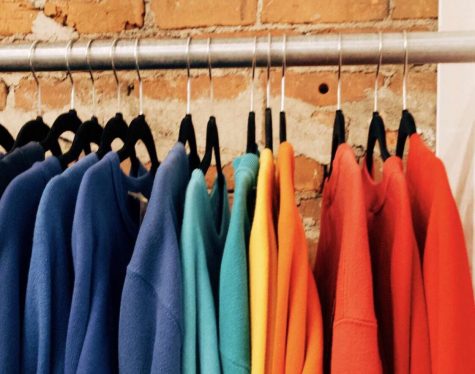By supporting thrifting instead of fast fashion, we begin to build a sense of sustainability within our community

When environmentalists talk about climate change and our increasing impact on the environment, the conversation consistently surrounds topics such as greenhouse gasses, CO2 emissions, and our carbon footprint. When they discuss the best ways to protect our precious last resources, renewable energy, environmental protection laws, and carbon taxes are frequent members of the conversation.
But for those who aren’t scientists, policymakers, environmental enthusiasts, Alexandria Ocasio-Cortez, or Greta Thunberg, the solutions may look a little different.
Protecting the environment isn’t just about knowing the ins-and-outs of the carbon process, the multifaceted issues surrounding renewable energy, or the best way to reduce factory waste; for those with a nine-to-five—or those still in high school—protecting the environment is as easy as buying secondhand clothes.
In the year I was born, clothing sales were around 1 trillion dollars. In 2015, clothing sales were around 1.8 trillion dollars. In 2025, clothing sales are expected to hit 2.1 trillion dollars.
The fashion industry is undeniably, exponentially growing.
And with it, it’s fatalistically devastating impact on the environment.
“The global apparel and footwear industry accounts for 8% of the world’s greenhouse gas emissions.” (Quantis 2018) That’s approximately four metric gigatonnes of CO2 being released into the atmosphere. And those numbers are only rising; CO2 is being released like a tsunami barreling towards land, soon to sweep us all away. “The fashion industry’s CO2 emissions are projected to increase to nearly 2.8 billion tons per year by 2030— equivalent to the emissions of 230 million passenger vehicles driven for a year.” (Global Fashion Agenda 2017)
The purchase of clothes from fast-fashion retailers —such as H&M, Forever 21, Hollister, and Old Navy—is an unreliable, unsustainable waste of resources that results solely in the advancement of crippling consumerism.
Fashion has become an industry of quantity over quality—and the prodigious quantity is suffocating the planet.
The production, transportation, and disposal of clothing affects the environment in a multitude of malicious ways. Heavy water consumption, air pollution, water pollution—20% of the global industrial levels, in fact—greenhouse gasses, and microfiber pollution ending in the ocean are just a few of the negative consequences that have been heightened by fast fashion.
“The volume of water consumed by the global fashion industry is 79 billion cubic meters, equivalent to 32 million Olympic-size swimming pools.” (Global Fashion Agenda 2017)
To put it in more personal terms, “[it] takes about 2,720 liters of water to produce just one cotton shirt – a number equivalent to what an average person drinks over three years.” (EJF) That means that every t-shirt you’ve gotten from a sporting event, organization, or simply for fun used the same amount of water you drank over the last three years. Think about it. How much water—in cotton form—is hanging up in your closet or folded in your drawers? And cotton isn’t even the most environmentally destructive fabric.
The production of synthetic fabrics involves awful amounts of petroleum, which has a heavy impact on the environment, both in extraction and disposal. Synthetics fabrics, due to their composition and the presence of plastics, are nonbiodegradable; the plastic fibers from the fabrics are being ingested and making their way into the food chain causing environmental and health issues at the same time.
And all of these clothes—whose creation is causing intense detriment to the environment—are just being thrown away: quickly. “Nearly three-fifths, or 60 percent, of all clothing produced ends up in incinerators or landfills within a year of being made.” (McKinsey 2016)
But there is a growing trend among teenagers, especially that both support the environment and the economy: thrifting—reducing, reusing, and recycling, all in one fell swoop.
By thrifting clothes instead of buying brand new ones, people can lessen the pressure placed on the environment by the fashion industry. When we support thrifting instead of fast fashion, we begin to build a sense of sustainability within our society that encourages people to do the small things they can and also teaches them that protecting the environment and being fiscally responsible can go hand-in-hand.
If the average life of clothing was extended by just three months, it would reduce their carbon and water footprints and waste generation by five to ten percent. The recycling of two million tons of clothing per year equates to taking one million cars from U.S. streets. And who doesn’t want to buy a shirt for five dollars instead of twenty?
Thrifting clothes, keeping clothes for longer, and being conscious of sustainable clothing alternatives are all ways in which the fate of Mother Earth rests in our hands—the hands of those who may not know the intricacies of hydropower but care about the planet nonetheless.

Ashlyn Korpak is a senior and entering her fourth and final year on The Central Trend. You can almost always find Ashlyn in The Central Trend room. But,...


























































































